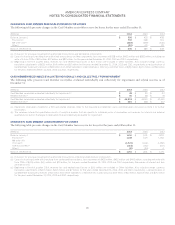American Express 2014 Annual Report Download - page 77
Download and view the complete annual report
Please find page 77 of the 2014 American Express annual report below. You can navigate through the pages in the report by either clicking on the pages listed below, or by using the keyword search tool below to find specific information within the annual report.
AMERICAN EXPRESS COMPANY
NOTES TO CONSOLIDATED FINANCIAL STATEMENTS
Interest Expense
Interest expense includes interest incurred primarily to fund Card Member loans, charge card product receivables, general corporate
purposes, and liquidity needs, and is recognized as incurred. Interest expense is divided principally into two categories: (i) deposits, which
primarily relates to interest expense on deposits taken from customers and institutions, and (ii) long-term debt and other, which primarily
relates to interest expense on the Company’s long-term financing and short-term borrowings, and the realized impact of derivatives hedging
interest rate risk.
BALANCE SHEET
Cash and Cash Equivalents
Cash and cash equivalents include cash and amounts due from banks, interest-bearing bank balances, including securities purchased under
resale agreements, and other highly liquid investments with original maturities of 90 days or less.
Premises and Equipment
Premises and equipment, including leasehold improvements, are carried at cost less accumulated depreciation. Costs incurred during
construction are capitalized and are depreciated once an asset is placed in service. Depreciation is generally computed using the straight-line
method over the estimated useful lives of assets, which range from 3 to 10 years for equipment, furniture and building improvements.
Premises are depreciated based upon their estimated useful life at the acquisition date, which generally ranges from 30 to 50 years.
Leasehold improvements are depreciated using the straight-line method over the lesser of the remaining term of the leased facility or the
economic life of the improvement, which ranges from 5 to 10 years. The Company maintains operating leases worldwide for facilities and
equipment. Rent expense for facility leases is recognized ratably over the lease term, and includes adjustments for rent concessions, rent
escalations and leasehold improvement allowances. The Company recognizes lease restoration obligations at the fair value of the restoration
liabilities when incurred, and amortizes the restoration assets over the lease term.
The Company capitalizes certain costs associated with the acquisition or development of internal-use software. Once the software is ready
for its intended use, these costs are amortized on a straight-line basis over the software’s estimated useful life, generally 5 years.
OTHER SIGNIFICANT ACCOUNTING POLICIES
The following table identifies the Company’s other significant accounting policies, the Note and page where the Note can be found.
Significant Accounting Policy
Note
Number Note Title Page
Accounts Receivable Note 3 Accounts Receivable and Loans Page 79
Loans Note 3 Accounts Receivable and Loans Page 79
Reserves for Losses Note 4 Reserves for Losses Page 84
Investment Securities Note 5 Investment Securities Page 86
Asset Securitizations Note 6 Asset Securitizations Page 88
Goodwill and Other Intangible Assets Note 7 Other Assets Page 89
Membership Rewards Note 10 Other Liabilities Page 95
Stock-based Compensation Note 11 Stock Plans Page 95
Retirement Plans Note 12 Retirement Plans Page 98
Legal Contingencies Note 13 Commitments and Contingencies Page 98
Derivative Financial Instruments and Hedging Activities Note 14 Derivatives and Hedging Activities Page 100
FairValueMeasurements Note15 FairValues Page104
Income Taxes Note 21 Income Taxes Page 113
Regulatory Matters and Capital Adequacy Note 23 Regulatory Matters and Capital Adequacy Page 116
Reportable Operating Segments Note 25 Reportable Operating Segments and Geographic Operations Page 118
77
























